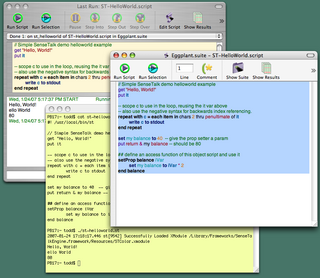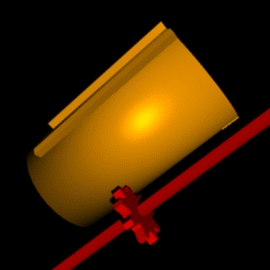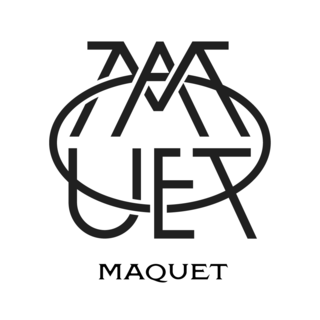
An electronic calculator is typically a portable electronic device used to perform calculations, ranging from basic arithmetic to complex mathematics.

An adding machine is a class of mechanical calculator, usually specialized for bookkeeping calculations. In the United States, the earliest adding machines were usually built to read in dollars and cents. Adding machines were ubiquitous office equipment until they were phased out in favor of electronic calculators in the 1970s and by personal computers beginning in about 1985. The older adding machines were rarely seen in American office settings by the year 2000.

This article presents a detailed timeline of events in the history of computing software and hardware: from prehistory until 1949. For narratives explaining the overall developments, see History of computing.

Leonardo Torres Quevedo was a Spanish civil engineer, mathematician and inventor, known for his numerous engineering innovations, including aerial trams, airships, catamarans, and remote control. He was also a pioneer in the field of computing and robotics. Torres was a member of several scientific and cultural institutions and held such important positions as the seat N of the Real Academia Española (1920–1936) and the presidency of the Spanish Royal Academy of Sciences (1928–1934). In 1927 he became a foreign associate of the French Academy of Sciences.

In mathematics and computing, the method of complements is a technique to encode a symmetric range of positive and negative integers in a way that they can use the same algorithm for addition throughout the whole range. For a given number of places half of the possible representations of numbers encode the positive numbers, the other half represents their respective additive inverses. The pairs of mutually additive inverse numbers are called complements. Thus subtraction of any number is implemented by adding its complement. Changing the sign of any number is encoded by generating its complement, which can be done by a very simple and efficient algorithm. This method was commonly used in mechanical calculators and is still used in modern computers. The generalized concept of the radix complement is also valuable in number theory, such as in Midy's theorem.

The Comptometer was the first commercially successful key-driven mechanical calculator, patented in the United States by Dorr Felt in 1887.

A mechanical calculator, or calculating machine, is a mechanical device used to perform the basic operations of arithmetic automatically, or (historically) a simulation such as an analog computer or a slide rule. Most mechanical calculators were comparable in size to small desktop computers and have been rendered obsolete by the advent of the electronic calculator and the digital computer.

Henri Herz was a virtuoso pianist, composer and piano manufacturer, Austrian by birth and French by nationality and domicile. He was a professor in the Paris Conservatoire for more than thirty years. Among his major works are eight piano concertos, a piano sonata, rondos, nocturnes, waltzes, marches, fantasias, and numerous sets of variations.

The IBM System/3 was an IBM midrange computer introduced in 1969, and marketed until 1985. It was produced by IBM Rochester in Minnesota as a low-end business computer aimed at smaller organizations that still used IBM 1400 series computers or unit record equipment. The first member of what IBM refers to as their "midrange" line, it also introduced the RPG II programming language. It is the first ancestor in the product line whose current version is the IBM i series and includes the highly successful AS/400.

The arithmometer was the first digital mechanical calculator strong enough and reliable enough to be used daily in an office environment. This calculator could add and subtract two numbers directly and could perform long multiplications and divisions effectively by using a movable accumulator for the result.

Pascal's calculator is a mechanical calculator invented by Blaise Pascal in 1642. Pascal was led to develop a calculator by the laborious arithmetical calculations required by his father's work as the supervisor of taxes in Rouen. He designed the machine to add and subtract two numbers directly and to perform multiplication and division through repeated addition or subtraction.

The French Industrial Exposition of 1844, held in a temporary structure on the Champs-Élysées in Paris, was the tenth in a series of eleven French national industrial expositions held since 1798 to encourage improvements in progressive agriculture and in technology.

André Jean Baptiste Robineau-Desvoidy was a French physician and entomologist specialising in the study of Diptera (flies), and to some extent of the Coleoptera (beetles).

The Elektronika MK-52 is an RPN-programmable calculator manufactured in the Soviet Union from 1983 to 1992 at the Quasar and Kvadr plants in Ukraine. It belongs to the third generation of Soviet programmable calculators. Its original selling price was 115 rubles.

SenseTalk is a high-level English-like scripting language in the XTalk family, that supports both procedural and object-oriented paradigms. SenseTalk scripts are intended to be largely readable by ordinary people, including those with little to no training in programming.
In 1979, Honeywell Information Systems announced a new programming language for their time-sharing service named TEX, an acronym for the Text Executive text processing system. TEX was a first-generation scripting language developed around the time of AWK and used by Honeywell initially as an in-house system test automation tool.

The printing telegraph was invented by Royal Earl House in 1846. House's telegraph could transmit around 40 instantly readable words per minute, but was difficult to manufacture in bulk. The printer could copy and print out up to 2,000 words per hour. This invention was first put in operation and exhibited at the Mechanics Institute in New York.

A Leibniz wheel or stepped drum is a cylinder with a set of teeth of incremental lengths which, when coupled to a counting wheel, can be used in the calculating engine of a class of mechanical calculators. Invented by Leibniz in 1673, it was used for three centuries until the advent of the electronic calculator in the mid-1970s.
The IBM System/360 architecture is the model independent architecture for the entire S/360 line of mainframe computers, including but not limited to the instruction set architecture. The elements of the architecture are documented in the IBM System/360 Principles of Operation and the IBM System/360 I/O Interface Channel to Control Unit Original Equipment Manufacturers' Information manuals.

Maquet is a French manufacturer of luxury stationery, leather goods, and art prints, established in Paris, in 1841 by the Maquet brothers, Hector and Charles. One of the most renowned Parisian luxury houses, Maison Maquet became official purveyor to Empress Eugénie as well as to several royal courts, winning multiple awards and medals at various World's fairs over the course of its history.


















